Welcome to the world of steel balls!
LESSON3 How steel balls are produced
- Kyusuke
- I’m understanding more and more about steel balls! But Professor, how are steel balls made?
- Professor Amatsuji
- That’s a good question, Kyusuke! Well, then, let’s go inside an Amatsuji Steel Ball Manufacturing Co., Ltd., plant and see how a common steel ball used in bearings is made!
Heading
A coil of wire is cut to the required length and each piece compressed and shaped into balls using a pressing machine.
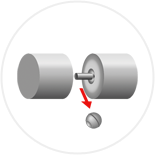
- Kyusuke
Wow, that’s so fast! How fast is that?
- Professor Amatsuji
It depends on the size of the ball, but the fastest machines can produce around 1,000 balls in one minute. Incidentally, the balls have only been compressed, and so they still have a protruding band around the middle, like a belt. This is removed in the next process.
Flashing
The surface of the balls is ground to remove the bands generated in the heading process.
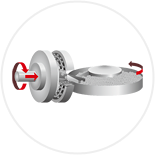
- Kyusuke
Professor! This is really loud, isn’t it?!
- Professor Amatsuji
Oh, that! The balls are being ground inside grooved metal disks at a tremendously high pressure. That’s why the noise is so loud!
- Kyusuke
What did you say?
I can’t hear! Please tell me again later!
Heat treatment
After the bands have been removed, the balls are quenched and tempered to give them sufficient strength and durability.
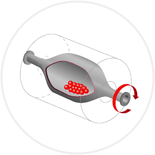
- Kyusuke
Gee, now it’s really hot!
- Professor Amatsuji
That’s because the balls are inside a retort furnace heated to a very high temperature of 800°C or more. Cooling the balls quickly from a high temperature changes the structure of the steel, making it harder. This process is called quenching. However, since the balls are still brittle, they are heated again to a high temperature to further strengthen them. This process is called tempering.
Grinding
In addition to removing parts decarburized in the heat treatment, this process adjusts dimensional precision and finishes the balls to the stipulated dimensional difference.
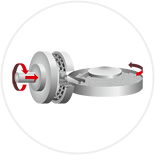
- Kyusuke
Hey, isn’t this process similar to what they were doing before? But this time the noise isn’t so loud.
- Professor Amatsuji
That’s very observant of you. In the previous process, the balls were ground inside metal disks, but here grindstone disks are used. Using a grindstone increases the dimensional precision of the finish. Changing the grinding disk also changes the dimensional precision of the balls.
First lapping
The dimensional precision of the balls is further improved and they are finished to the specified dimensional difference.
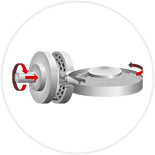
- Kyusuke
Hey, this process is also similar to the previous ones. Can’t they just do it once?
- Professor Amatsuji
Even though grinding improves the dimensional precision, this is still a far cry from the precision required in the product. Processing the balls using grindstone with a finer granularity than before increases the precision of the balls and stabilizes product quality.
Second lapping
In addition to increasing the balls’ dimensional precision to grade level, this process gives the surface of the balls a smooth, glass-like finish.

- Kyusuke
Wow, that’s shiny!
Is the grindstone used in this process
different from the one used just before?
- Professor Amatsuji
You are a clever boy, Kyusuke! The process here uses an ever finer grindstone than the one used in the first lapping process. Processing the balls over and over again produces more spherical, shiny balls!
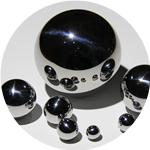
Visual inspection
All of the finished steel balls and all of their surfaces are visually inspected automatically. These visual inspections ensure that the balls supplied to customers have no flaws.
- Kyusuke
What?
Are all of the balls inspected?
- Professor Amatsuji
That’s right! Inspecting all of the balls and all of their surfaces ensures that no flawed balls are distributed. From the users’ perspective, inspecting all of the products is assuring, isn’t it? These careful inspections are another reason why Amatsuji products are know as the “World’s No. 1.”
Packing
Balls that pass visual inspection are treated with anti-corrosive oil and then packed in paperboard boxes.
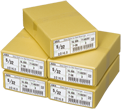
- Kyusuke
How many kilograms does one box weight?
- Professor Amatsuji
Each box weights 4 kg. This has been set at the weight that a person can lift with one hand. Cardboard boxes weight 20 kg in consideration of the weight a person can safely carry. This consideration for safety after products have been shipped is typical of AKS.
- Kyusuke
Completed at last!
Professor, I got a ball as a souvenir!
- Professor Amatsuji
That’s wonderful! Each of these balls is packed with the world’s top technology.
Make sure you take care of them!